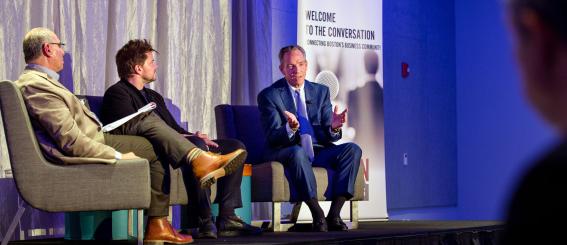Driven Series Pairs Leading Building Innovators in Cutting-Edge Conversation
November 9, 2017

“Today, we build much more predictable structures than in the past,” remarked John Fish, Chairman and CEO of Boston-based Suffolk, one of the nation’s leading building contractors. “First, we build a digital twin of the building—a virtual model of the building itself. Then we transfer it into a 3-dimensional cave. That allows us to see the building’s components, their relationships, and proportions, which we analyze for predictability and collaboration.”
In January of 2019, Isenberg will reap a windfall from best practices like those when its $62M Business Innovation Hub opens full-time for the spring 2019 semester. Conceived, designed, and coordinated by the Boston architects, Goody Clancy, and the Copenhagen- and Manhattan-based architectural design firm, Bjarke Ingels Group (BIG), the 70,000 square-foot Innovation Hub will change the face of Isenberg and expand its resources for the next generation of its students.
On November 1, John Fish and BIG founder and Creative Director Bjarke Ingels discussed cutting-edge issues in building and urban architecture and design in Driven: A Conversation with..., Isenberg’s Boston-based speaker series. Moderated by WBUR journalist Bruce Gellerman, the Boston-centric discussion at the Aloft Seaport Hotel proved a dynamic successor to its two Driven predecessors, featuring Apple cofounder Steve Wozniac and ZipCar founder Robin Chase.
Care and Empathy Rule. Complementing Fish’s emphasis on predictability, Ingels added, “It comes down to the care invested in [the project]. That’s when you care about asking specific questions: How will this building be used? How can it do more? How can it open up more? How will it invite people in? Take advantage of the daylight? Offer shelter from the wind?” When you address those questions architecturally, he continued, your building will look slightly different from “the standard solution.” That will include, he said, its ability to mesh aesthetics and functionality with the city and environment around it. Avoid buildings, he cautioned, with an isolated identity! They are analogous to “selfish egomaniacs.”

A City Looks Forward. Seconding Ingels’ emphasis on “potential,” Fish noted that after viewing striking “statement buildings” and accompanying development in Boston’s Seaport district, Bostonians “now believe that [the district’s revitalization] is “a great long-term investment.” With its growing investments in bold redevelopment and infrastructure in more and more of the city, “Boston,” he said, “is in the best shape ever. [Architecturally speaking], it has been discovered globally!
“Boston is opening up its architecture to more creative design,” he continued. Its “young, curious, well-educated population is willing to listen to [and accept] differences.” That goes for his own firm, which recently moved into expanded, repurposed headquarters in Roxbury. To that end, the firm followed the lead of its predominantly millennial workforce, which favored open community spaces for production, collaboration, and camaraderie. The upshot: many of its internal walls vanished, because “people really cared about each other [and collaboration] as a core value. For Suffolk and Fish, that proved revelatory: “As a company, you don’t define your core values; you discover them,” he emphasized.
A Bostonian Roundabout. As moderator, Gellerman steered the Boston-focused conversation through a cityscape of diverse topics, including the evolution of autos and transportation networks, the role of iconic buildings, the dance between form and function, political tradeoffs, and sustainability challenges. “Our cities are shaped by how we move around in them . . . If you think you can use the car for everything, you’re wrong,” Ingels insisted. “Does a city need an iconic building? Gellerman asked, noting that UMass was getting one with Isenberg’s Innovation Hub.
Fish applauded Governor Baker’s ambitious investments in infrastructure, adding, “They will never get a politician reelected. He’s betting on technology and infrastructure, but we won’t see the benefits for the next 18 months.” Although fraught with political risk, “I think it’s the biggest game changer in Massachusetts in the last 25 years,” he added. [On the bright side], “People are driven by tech to collaborate. The best of Boston is yet to come.” Chiming in, Ingels added, “Almost no project is done in four years, except,” he quipped, “Isenberg.” Politics, he noted, can be “narrow-minded and short-sighted— bad for holistic things."
“If a [project’s] investor is not a long-term owner, why [would he] invest in sustainability?” Ingels continued. While that remains a challenge, Fish noted marked progress: “Awareness and sensitivity to climate change [and sustainability] is now front and center,” he remarked. “Five years ago [our response] was a reaction. [Today], we are willing to pay [those necessary] premiums.”